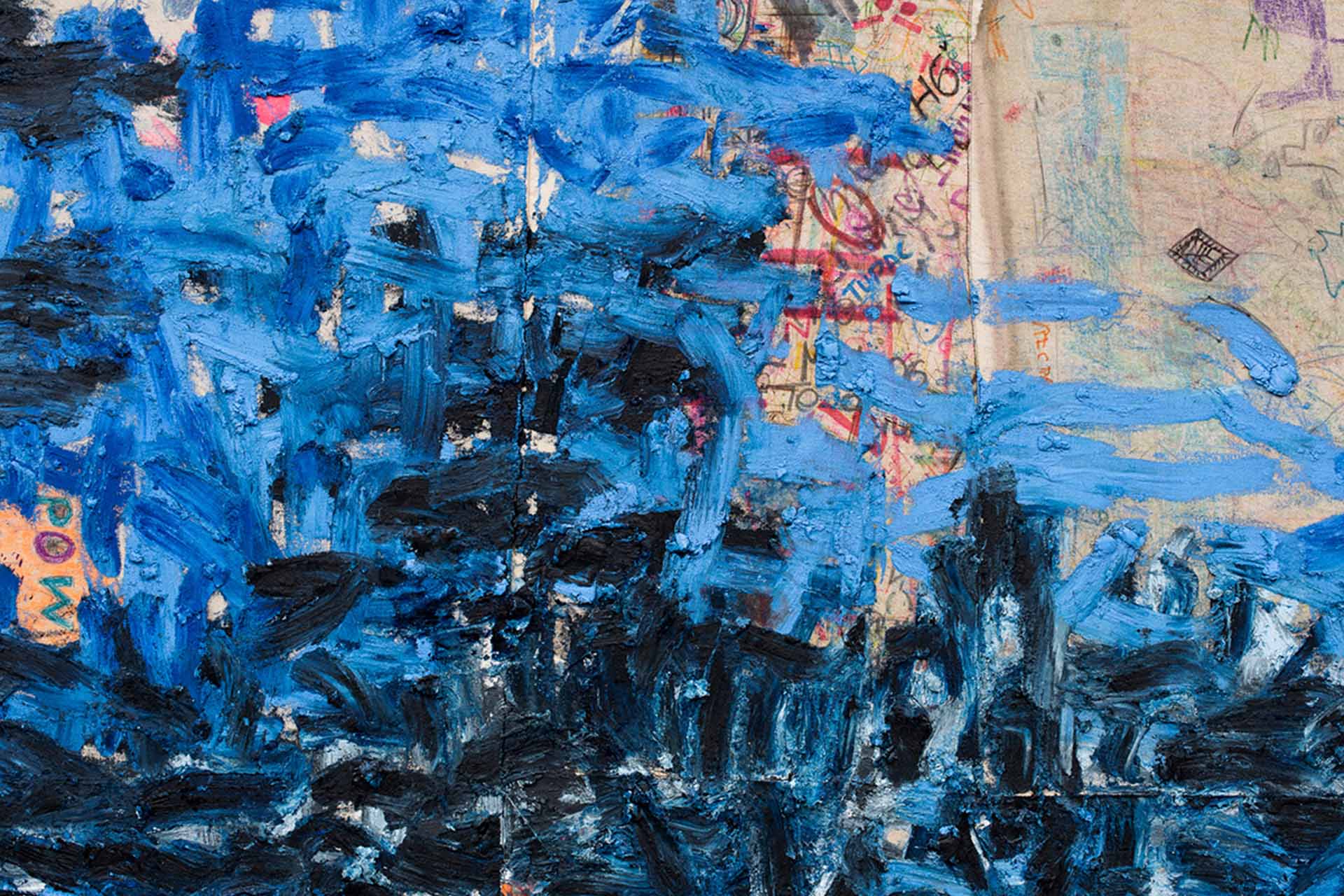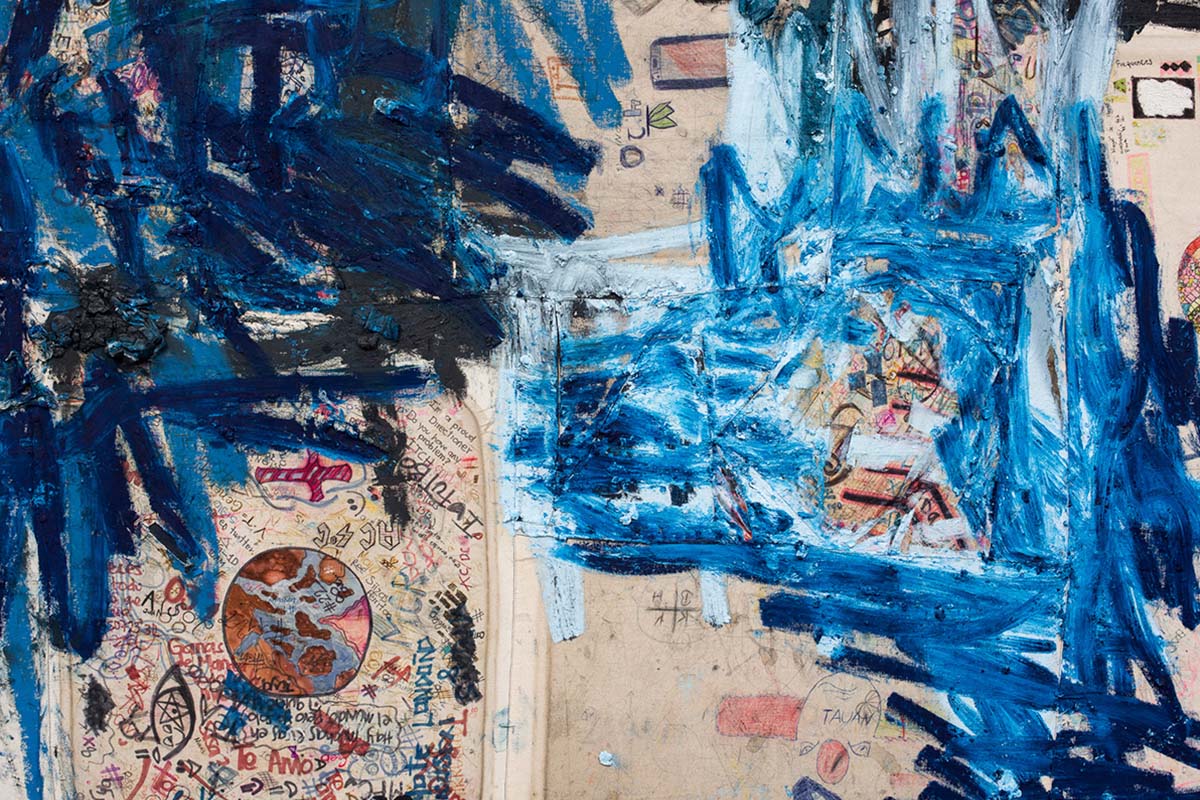The storm of progress theorized by Walter Benjamin takes the form of thousands of drawings and marks made in almost ten years by children and school students worldwide
A Storm Is Blowing From Paradise by Oscar Murillo
In the historic setting of the Scuola Grande della Misericordia, located in the Cannaregio district in the city center of Venice, paintings, installation and digital works by Oscar Murillo are brought together to create a solo exhibition titled A Storm Is Blowing From Paradise.
At the core of Murillo’s art show is Frequencies, a nine-year-long project carried out with thousands of school students aged 10-16 from over 400 schools world-wide. The project consists in fixing artists’ canvases to the desks of the classrooms and letting kids express their creativity through freehand drawings, writings and doodles. According to the artist, the idea of Frequencies stemmed from his interest in mark-making, primitivism and the evolution of art across history, from cave painting to modernist tendencies. To this date, the collection is made up of over 40.000 canvases and presents itself as a multilayered sedimentation of information and data.
A Storm Is Blowing From Paradise – the inspiration behind the title
The title of the exhibition is taken from a passage from the 1940 volume On the concept of history by the German philosopher and critic Walter Benjamin. In the passage Benjamin speaks of a painting by Paul Klee named Angelus Novus. The artwork depicts an angel with spread wings ready to take off, but with his gaze fixed on something close to him – maybe behind. According to the German philosopher, that is the depiction of the angel of history constantly looking at the past and trying to reconnect the fragments and the rubble left by the catastrophes of the human world which follow each other and overlap continuously.
At the same time, an external force requires him to keep on moving: «a storm is blowing from Paradise; it has got caught in his wings with such violence that the angel can no longer close them. The storm irresistibly propels him into the future to which his back has turned, while the pile of debris before him grows skyward. The storm is what we call progress».
Oscar Murillo presents Frequencies, project in collaboration with schools world-wide
On the ground floor of the building, thousands of canvases from thirty-four countries are organized into piles which occupy numerous shelves displaced all over the room. Visitors are invited to interact with them with the aid of the archive assistants who, upon request, bring canvases from specific countries or cities to the tables.
A peculiarity of Frequencies is the difference of each canvas varying not only from country to country, but also according to the sensitivity, taste and also skills of the kids who intervened on its surface. Specific reference to the national customs and traditions alternate with global elements of pop culture, from song lyrics to comics and football clubs crests. There are subjects – such as music and tv stars – who occur more frequently, regardless of the geographic origin of the canvases.
Lampoon – a conversation with Oscar Murillo
«When we first started Frequencies, the project was not about children per se. It was more about seeing children as the only vessels of purity in human existence before starting their process of indoctrination. Whether they come from Italy, South Africa or Singapore, the school system structure “teacher-student” is very similar and standardized. There is a friction between the purity of the mind and the soul, and the dogma of society, which dictates how the people who belong to it should be or behave», Murillo explains.
Despite an ambivalent message residing in the words of Benjamin, Murillo chooses to have faith in the future generations. Kids are in fact the only messengers of positivity and hope, capable of overcoming the disillusionment of adulthood.
Disrupted Frequencies in the Scuola Grande in Venice
Wandering through the wide spaces of the ground floor of the Scuola Grande, visitors come across Murillo’s paintings from the Disrupted Frequencies series scattered among the shelves. The paintings consist of individual canvases stitched together to create new panels on which Murillo has intervened with audacious strokes of vivid blue-toned oil. As he created these panels, Murillo pulled together individual membranes of information and data from different parts of the world.
«There are several types of frequencies: radio frequencies to tune into, geographical frequencies, economic frequencies. And we have regional differences: in Nepal we talk about altitude, in New York we talk about economy and social issues, in Mumbai there is a clear sedimentation of intensity and time, in Singapore the awareness of a conservative society. In a way these readings are also cliché in relation to how we read or want to believe certain societies are, so the paintings represent my desire to add friction to a project which has been very fluid and organic in its evolution. Painting on the marks you cancel the information, and as you cancel it, the information becomes more important. That is where the challenge of finding a balance between aesthetics and legibility of information comes in».
Oscar Murillo on the digitization of the collection
Four years ago, Murillo decided to digitize the archive of Frequencies in order to explore how it could be brought into a more contemporary form of communication. From this exploration stemmed collective conscience (2022), an enclosed room in which visitors can discover the digital evolution of Arepas y Tamales, a recent project in which drawings from canvases have been translated into a series of wearable sculptures.
Through artificial intelligence technologies, he selected and extracted some drawings and motifs from the canvases and transformed them into emblems which now cover the surfaces of garments and tapestry placed in the middle of the room. Elements and characters from individual canvases are blended together to create a new visual language invented and shared by thousands of children across the globe.
Drawing inspiration from work uniforms, with his wearable sculptures Murillo makes a reference to one of the most recurrent topics in his research: labor and its role within contemporary society. Finally, the sound permeating the space provides another exploration of Frequencies. Storm From Paradise (2022) is a sound installation composed of layered “sound particles” extracted by sound engineers from recordings made in different environments: school play-grounds, urban settings, sport courts. The noises which unfold following seemingly random patterns, actually respond in real time to the tracking of flights and international plane routes chosen by Murillo.
The first floor of the Scuola Grande hosts the second part of the exhibition
The Institute of Reconciliation (2014 – ongoing) consists of a big-size installation made of coal-black drapes hanging from the ceiling, a visual manifestation of the storm. On the other hand these gloomy and ominous presences also symbolize hope and positivity, represented by sudden bursts of light piercing the dark. «Among my influences is Monet. However my understanding of his work was very limited until I read his biography and discovered he suffered from cataracts when he was painting the waterlilies. It is incredible to think how an artist with such a great aesthetics and ability had cataracts», Murillo claims. In the context of The Institute of Reconciliation cataracts is also a metaphor for a blind world.
In this labyrinthic atmosphere – enhanced by the pungent smell of the oil paint of which the drapes are steeped – visitors also encounter works from Murillo’s Flight Drawing series. These works were created by Murillo during air travel. In a situation of physical immobility – although he was moving between places at a high speed – he recorded momentary impressions through instinctive mark-making, availing of an approach similar to the creative process behind the students’ canvases.
A pile of rock-like sculptures of clay and corn is surrounded by Murillo’s (untitled) surge paintings
The symbolism of translocality and movement between different regions of the world can be found in another work filling a big portion of the first floor. A pile of rock-like sculptures of clay and corn, primary food source for many people across the globe, is surrounded by Murillo’s (untitled) surge paintings. These canvases are dominated by the blue color which recalls not only the water flowing in the canals of Venice, but also the blue water of seas and oceans covering the majority of the Earth’s surface.
The cultural meanings and symbols disseminated by A Storm Is Blowing From Paradise are amplified by the public program of SAVVY Contemporary, a Berlin-based art space. Through talks, performances and music interludes, SAVVY Contemporary aims at deepening the topics addressed by Murrillo: the experience of the diaspora, the mitigation of differences and the senses of belonging. «Things which present some differences come together through mark-making, aesthetics, gesture, drawing, antagonis. This is what the whole show is about».
Oscar Murillo
Oscar Murillo was born in 1986 in La Paila, Colombia, and lives and works in various locations. He received a Bachelor of Fine Arts (Hons) from the University of Westminster in 2007 and a Masters Degree from the Royal College of Art in London in 2012. In 2019, Murillo was one of four artists to collectively receive the prestigious Turner Prize.
Oscar Murillo has created a visual language that contains recurring elements and motifs; draped black canvases; large paintings composed of fragments sewn together; metal structures that evoke autopsy boards and rock-like sculptures made from corn and clay. These and other components unfold across a wide range of media, including room-sized painting, video work, installations and actions.




















